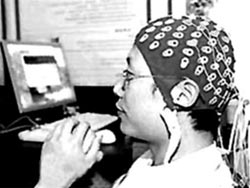 |
|
A student remotely controls a robot dog’s activity (small image) using brain waves – Photo: Xinhua |
On a 2-meter-long green carpet, a pink robot dog guards the goal, while a white robot dog dribbles a soccer ball into the net. This scenario would not be extraordinary if the actions of these two robot dogs were not directed by two students using their thoughts through a brain-computer interface system recently developed by experts from the Neuroscience Research Institute at Tsinghua University (China).
This system consists of an electrode cap, an electroencephalography (EEG) transmitter, and a data processing computer. According to Dr. Hong Ba, a member of the research team, when a person thinks, there is electrical activity on the scalp, which is recorded and commonly referred to as brain waves.
This type of brain wave is collected by the system, which then filters and categorizes the signals automatically to interpret human thoughts. Subsequently, the computer analyzes the interpreted thought state into control commands and transmits them via wireless networks.
This type of machine system is currently being researched in China for practical applications to assist people with disabilities who have limited mobility but normal cognitive function, enabling them to control wheelchairs, prosthetic limbs, and even type directly through their thoughts. Additionally, it could be applied in military, manufacturing, and entertainment fields…
 However, this system has limitations in speed, and when visual stimulation is needed to a certain degree, it increases brain wave activity, leading to a flickering sensation when inputting data. In the future, there is potential to streamline and combine the EEG transmitter and the data processing unit into a compact device the size of a phone, with mass-produced costs estimated to be around 2,000 – 3,000 yuan (4-6 million VND).
However, this system has limitations in speed, and when visual stimulation is needed to a certain degree, it increases brain wave activity, leading to a flickering sensation when inputting data. In the future, there is potential to streamline and combine the EEG transmitter and the data processing unit into a compact device the size of a phone, with mass-produced costs estimated to be around 2,000 – 3,000 yuan (4-6 million VND).
Currently, Germany and the United States also have similar brain-computer interface systems, but according to Professor Hong Ba, the accuracy of the information processing in the system developed by Tsinghua University “is the best in the world.” He mentioned that his research team has been studying the field of recognition and processing of mental signals for nearly 20 years.
UYÊN KIM
















































